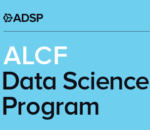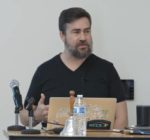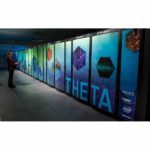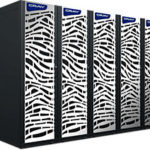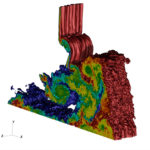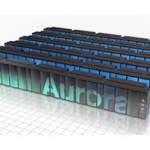The ALCF Data Science Program at Argonne has issued its Call for Proposals. The program aims to accelerate discovery across a broad range of scientific domains which require data-intensive and machine learning algorithms to address challenging research problems. “Ongoing and past ADSP projects span a diverse range of science domains, e.g. Materials, Imaging, Neuroscience, Engineering, Combustion/CFD, Cosmology; and involve large science collaborations.”
Video: Managing large-scale cosmology simulations with Parsl and Singularity
Rick Wagner from Globus gave this talk at the Singularity User Group “We package the imSim software inside a Singularity container so that it can be developed independently, packaged to include all dependencies, trivially scaled across thousands of computing nodes, and seamlessly moved between computing systems. To date, the simulation workflow has consumed more than 30M core hours using 4K nodes (256K cores) on Argonne’s Theta supercomputer and 2K nodes (128K cores) on NERSC’s Cori supercomputer.”
Video: Argonne’s Theta Supercomputer Architecture
Scott Parker gave this talk at the Argonne Training Program on Extreme-Scale Computing. “Designed in collaboration with Intel and Cray, Theta is a 9.65-petaflops system based on the second-generation Intel Xeon Phi processor and Cray’s high-performance computing software stack. Capable of nearly 10 quadrillion calculations per second, Theta will enable researchers to break new ground in scientific investigations that range from modeling the inner workings of the brain to developing new materials for renewable energy applications.”
Mapping the Brain with the Theta Supercomputer
Researchers are using the Theta supercomputer at Argonne to map the intricate layout of brain neurons. “The basic goal is simple — would like to be able to image all of the neurons in the brain — but the datasets from X-rays and electron microscopes are extremely large,” said Doga Gursoy, assistant computational scientist in the X-Ray Science Division of Argonne’s Advanced Photon Source. They are at the tera- and petabyte scales. So we would like to use Theta to build the software and codebase infrastructure in order to analyze that data.”
Argonne to Install 1.5 Petaflop Cray CS400 Cluster
Today Cray announced a contract to deliver a Cray CS400 cluster supercomputer to the Laboratory Computing Resource Center (LCRC) at Argonne National Laboratory. The new Cray system will serve as the Center’s flagship cluster, and in continuing with LCRC’s theme of jazz-music inspired computer names, the Cray CS400 system is named “Bebop.”
Argonne Annouces Early Science Projects for Aurora Supercomputer
Argonne has selected 10 computational science and engineering research projects for its Aurora Early Science Program starting this month. Aurora, a massively parallel, manycore Intel-Cray supercomputer, will be ALCF’s next leadership-class computing resource and is expected to arrive in 2018. The Early Science Program helps lay the path for hundreds of other users by doing actual science, using real scientific applications, to ready a future machine. “As with any bleeding edge resource, there’s testing and debugging that has to be done,” said ALCF Director of Science Katherine Riley.
Podcast: What a Supercomputer Does
In this WBEZ podcast, Katherine Riley from Argonne explains what a supercomputer does. “Argonne National Laboratory is celebrating its 70th anniversary. The science and engineering research center has had a prominent place in historical research developments. They’re currently in the process of installing their newewst supercomputer, Theta.”
Paving the Way for Theta and Aurora
In this special guest feature, John Kirkley writes that Argonne is already building code for their future Theta and Aurora supercomputers based on Intel Knights Landing. “One of the ALCF’s primary tasks is to help prepare key applications for two advanced supercomputers. One is the 8.5-petaflops Theta system based on the upcoming Intel® Xeon Phi™ processor, code-named Knights Landing (KNL) and due for deployment this year. The other is a larger 180-petaflops Aurora supercomputer scheduled for 2018 using Intel Xeon Phi processors, code-named Knights Hill. A key goal is to solidify libraries and other essential elements, such as compilers and debuggers that support the systems’ current and future production applications.”
Video: Theta & Aurora – Big Systems for Big Science
“Aurora’s revolutionary architecture features Intel’s HPC scalable system framework and 2nd generation Intel Omni-Path Fabric. The system will have a combined total of over 8 Petabytes of on package high bandwidth memory and persistent memory, connected and communicating via a high-performance system fabric to achieve landmark throughput. The nodes will be linked to a dedicated burst buffer and a high-performance parallel storage solution. A second system, named Theta, will be delivered in 2016. Theta will be based on Intel’s second-generation Xeon Phi processor and will serve as an early production system for the ALCF.”
Argonne Selects Theta Supercomputer Early Science Projects
Today the Argonne Leadership Computing Facility (ALCF) announced the selection of six projects for its Theta Early Science Program (ESP), a collaborative effort designed to help prepare scientific applications for the architecture and scale of the new supercomputer.

